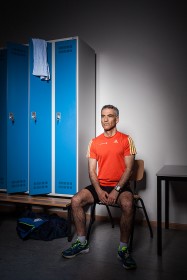The 14th European Maccabi Games (EMG) are taking place in Berlin from 27 July until 5 August 2015. More than 2,000 Jewish athletes from 36 countries will compete in 19 sports from football to fencing to chess. To accompany the games Tamar Lewinsky and Theresia Ziehe are producing a series of portraits with interviews, introducing a new member of the German delegation from Berlin every day here on the blog. They conducted the interviews on the grounds of the TuS Maccabi in Berlin’s Grunewald where Stephan Pramme also shot the portraits.
Dr. Alon Padovicz, 60, half-marathon

Alon (60) Half Marathon © Jewish Museum Berlin, photo: Stephan Pramme
What meaning do you feel it has, that the European Maccabi Games are taking place in Berlin, and in particular at the Olympic Stadium? It’s a place of symbolic importance since Jewish athletes weren’t allowed to participate in the 1936 Olympics…
To be honest, for me it’s nothing special. I’ve lived in Berlin for more than 50 years, and it’s normal to me that Jews come to Berlin or undertake some project in Berlin. Even the place – the Olympic Stadium – isn’t extraordinary to me. I often participate in competitive events in Berlin, for instance in the 25-kilometer race, and we always finish at the Olympic Stadium. It’s not a new feeling for me. I think it’s nice that we can do this here. But I’m not drawing the big arc back to 1936, although I am of course aware of the historical significance.
And being part of the German delegation – what role does that play for you? → continue reading
On Why the Death of Stuart Hall Is a Loss for our Academy Programs
Stuart Hall, the renowned British cultural theorist and sociologist, passed away exactly one month ago, on 10 February 2014. His death prompted in us a deep sense of personal loss. His groundbreaking writings on cultural studies, in particular on racial inequality, were first translated into German in the mid 1990s—a time when people here were beginning to acknowledge the importance of racism as an issue.

Silent vigil of the Jewish Community at the Putlitz Bridge Deportation Memorial
Photo: Michael Kerstgens, Berlin Tiergarten, 1992
Hall’s approach incited a new discussion and coined a new vocabulary: until then, Germans in the Federal Republic had spoken of “Fremdenfeindlichkeit” (xenophobia), which they regarded as a marginal social phenomenon. Politicians and the media spoke matter-of-factly of society “reaching breaking point” when “the boat gets too full” owing to “Überfremdung.” The latter term denotes the state of ‘being overrun by foreigners.’ It is itself deeply racist and was accordingly voted Non-word of the Year 1993. “Being overrun” was presumed however to be explanation enough for the fire-bombings and other attacks then being carried out almost daily on asylum-seekers’ accommodation centers or immigrants’ apartments—and likewise for the hate campaigns, man-hunts, and pogrom-type riots erupting in Rostock, Hoyerswerda, and elsewhere, or the emergence of no-go areas in other towns and rural centers. In consequence, the law on asylum was altered in 1993 such that judicial opinion held it to have been “de facto repealed.” Therefore, anyone who wished to address the issue of racism as a structural phenomenon and thereby draw on theoretically sound academic sources had necessarily to turn to authors from England, France, the USA, or Canada—and repeatedly to Stuart Hall. → continue reading
During the week of October 21 to 27, 2013 the Academy of the Jewish Museum Berlin, in cooperation with Kulturkind e.V., will host readings, workshops, and an open day for the public with the theme “Multifaceted: a book week on diversity in children’s and young adult literature.” Employees of various departments have been vigorously reading, discussing, and preparing a selection of books for the occasion. Some of these books will be introduced here over the course of the next few months.
 The German cover of the young adult book A Time of Miracles shows a girl balancing in shallow water on a barrel. It strikes me as a pretty, melancholy cover. However, it doesn’t fit the book. (The beach plays no role in the story and the protagonist is a boy.) I hand the book to my 12-year-old daughter and she thinks it looks like a book for adults. My question – whether this is a good or a bad thing – is answered with a shrug.
The German cover of the young adult book A Time of Miracles shows a girl balancing in shallow water on a barrel. It strikes me as a pretty, melancholy cover. However, it doesn’t fit the book. (The beach plays no role in the story and the protagonist is a boy.) I hand the book to my 12-year-old daughter and she thinks it looks like a book for adults. My question – whether this is a good or a bad thing – is answered with a shrug.
Never judge a book by its cover.
Crack it open and read: → continue reading


